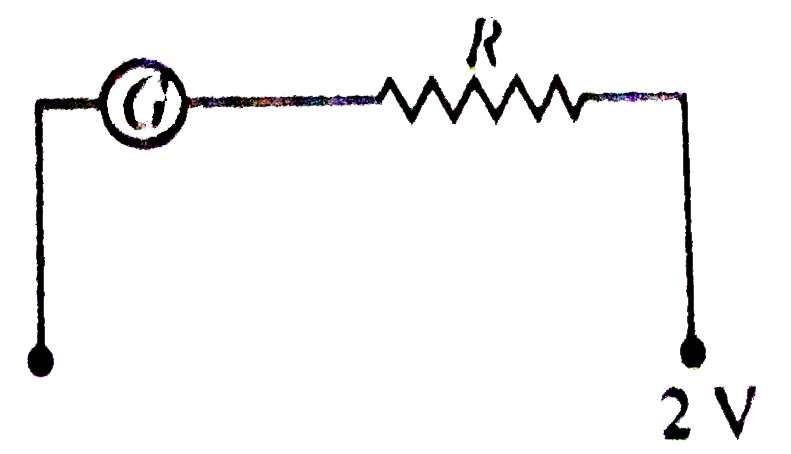A galvanometer measures current which passes through it. A galanometer can measure typically carrent of order of mA. To be able to measure currents of the order of amperes of main current, a shunt resistance 'S' is connected in parallel with galvanometer.
If resistance of galavonometer is and maximum current is 10mA then the shunt resistance required so that the main current 'I' can be upto 1A is (in )
990
To find the shunt resistance S required for the galvanometer to measure a maximum current of 1 A, we can follow these steps:
Step 1: Understand the Circuit Configuration
The galvanometer (with resistance G) and the shunt resistance S are connected in parallel. The total current I splits into two parts: the current through the galvanometer Ig and the current through the shunt Is.
Step 2: Write the Current Relationship
According to Kirchhoff's current law, we have:
I=Ig+Is
Where:
- I is the total current (1 A)
- Ig is the maximum current through the galvanometer (10 mA or 0.01 A)
- Is is the current through the shunt resistance
Step 3: Calculate the Current through the Shunt
From the previous relationship, we can express Is:
Is=I−Ig=1A−0.01A=0.99A
Step 4: Use Ohm's Law for the Galvanometer and Shunt
The potential difference across both the galvanometer and the shunt is the same. According to Ohm's law:
V=Ig⋅G=Is⋅S
Where:
- G is the resistance of the galvanometer (10 Ω)
Step 5: Substitute Known Values
Substituting the known values into the equation:
Ig⋅G=Is⋅S
0.01A⋅10Ω=0.99A⋅S
This simplifies to:
0.1V=0.99A⋅S
Step 6: Solve for Shunt Resistance S
Rearranging the equation to solve for S:
S=0.1V0.99A≈0.10101Ω
Step 7: Final Calculation
To express this in a more manageable form:
S≈1099Ω
Conclusion
Thus, the required shunt resistance S is approximately:
S≈0.101Ω
The galvanometer (with resistance G) and the shunt resistance S are connected in parallel. The total current I splits into two parts: the current through the galvanometer Ig and the current through the shunt Is.
According to Kirchhoff's current law, we have:
I=Ig+Is
Where:
- I is the total current (1 A)
- Ig is the maximum current through the galvanometer (10 mA or 0.01 A)
- Is is the current through the shunt resistance
From the previous relationship, we can express Is:
Is=I−Ig=1A−0.01A=0.99A
The potential difference across both the galvanometer and the shunt is the same. According to Ohm's law:
V=Ig⋅G=Is⋅S
Where:
- G is the resistance of the galvanometer (10 Ω)
Substituting the known values into the equation:
Ig⋅G=Is⋅S
0.01A⋅10Ω=0.99A⋅S
This simplifies to:
0.1V=0.99A⋅S
Rearranging the equation to solve for S:
S=0.1V0.99A≈0.10101Ω
To express this in a more manageable form:
S≈1099Ω
Thus, the required shunt resistance S is approximately:
S≈0.101Ω
Topper's Solved these Questions
Similar Questions
Knowledge Check
If the galvanometer current is 10 mA, resistance of the galvanometer is 40Ω and shunt of 2Ω is connected to the galvanometer, the maximum current which can be measured by this ammeter is
A0.21AB2.1AC210AD21A
A moving coil galvanometer has a resistance of 990Ω. in order to send only 10% of the main currect through this galvanometer, the resistance of the required shunt is
View SolutionThe senstivity of a galvanometer that measures current is decreased by 1/40 times by using shunt resistance of 10Ω . Then, the value of the resistance of the galvanometer is
View SolutionIn a galvanometer 5% of the total current in the circuit passes through it. If the resistance of the galvanometer is G, the shunt resistance 'S' connected to the galvanometer is
View SolutionA voltmeter which can measure 2 V isconstructed by using a galvanometer of resistance 12Ω and that produces maximum deflection for the current of 2mA. Then the resistance R is

View SolutionThe maximum current in a galvanometer can be 10 mA. Its resistance is 10Ω. To convert it into an ammeter of 1 A, what resistance should be connected in parallel with galvanometer (in 10−1Ω)?
View SolutionTo measure the resistance of a galvanometer by half deflection method, a shunt is connected to the galvanometer . The shunt is
View SolutionA resistance box, a battery and a galvanometer of resistance G ohm are connected in series. the galvanometer is shunted by resistance of S ohm, find the change in resistance in the be required to maintain the current from the battery unchanged.
View Solution

